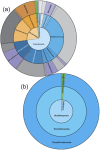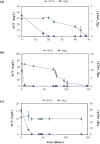Biodegradation of thiocyanate by a native groundwater microbial consortium
- PMID: 30941266
- PMCID: PMC6440457
- DOI: 10.7717/peerj.6498
Biodegradation of thiocyanate by a native groundwater microbial consortium
Abstract
Gold ore processing typically generates large amounts of thiocyanate (SCN-)-contaminated effluent. When this effluent is stored in unlined tailings dams, contamination of the underlying aquifer can occur. The potential for bioremediation of SCN--contaminated groundwater, either in situ or ex situ, remains largely unexplored. This study aimed to enrich and characterise SCN--degrading microorganisms from mining-contaminated groundwater under a range of culturing conditions. Mildly acidic and suboxic groundwater, containing ∼135 mg L-1 SCN-, was collected from an aquifer below an unlined tailings dam. An SCN--degrading consortium was enriched from contaminated groundwater using combinatory amendments of air, glucose and phosphate. Biodegradation occurred in all oxic cultures, except with the sole addition of glucose, but was inhibited by NH4 + and did not occur under anoxic conditions. The SCN--degrading consortium was characterised using 16S and 18S rRNA gene sequencing, identifying a variety of heterotrophic taxa in addition to sulphur-oxidising bacteria. Interestingly, few recognised SCN--degrading taxa were identified in significant abundance. These results provide both proof-of-concept and the required conditions for biostimulation of SCN- degradation in groundwater by native aquifer microorganisms.
Keywords: Bioremediation; Contamination; Geomicrobiology; Groundwater; Microorganisms; Mining; Sulphurs-oxidation; Thiocyanate.
Conflict of interest statement
John W. Moreau is an Academic Editor for PeerJ (Environmental Science). All other authors declare that they have no competing interests.
Figures




References
-
- Aguirre NV, Vivas BP, Montes-Moran MA, Ania CO. Adsorption of thiocyanate anions from aqueous solution onto adsorbents of various origin. Adsorption Science Technology. 2010;28(8–9):705–716. doi: 10.1260/0263-6174.28.8-9.705. - DOI
-
- Baethgen WE, Alley MM. A manual colorimetric procedure for measuring ammonium nitrogen in soil and plant Kjeldahl digests. Communications in Soil Science and Plan Analysis. 1989;20(9–10):961–969. doi: 10.1080/00103628909368129. - DOI
LinkOut - more resources
Full Text Sources

